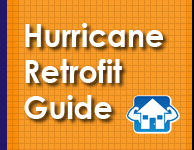|
Because your roof is so important to the survival of your house and your possessions, you might
want to start your exploration of this website by looking over the information on
Roofs. You will learn how your roof and
your attic ventilation system can make your house vulnerable to damage in a hurricane
and what kinds of things can be done to reduce these risks.
Next to the roof, the greatest risk for most houses is the failure of a window or door. To learn more about windows
and doors and how they can be protected you might want to click on Windows, Doors & Shutters.
Don't overlook reading about leaks in the various sections of this guide. Once you get to the point where you don't have
water pouring into your house from missing roof sheathing or a failed window or door, leaks can occur through
your attic ventilation system, around windows and doors, and lots of other places that you might not have
thought of, resulting in lots of damage and possibly mold. There are suggestions for reducing leaks
in almost every section that deals with a part of your house.
As wind speeds climb above Saffer-Simpson Category 1 level, the importance of having all parts of your house connected together
and working as a system to resist the wind forces becomes more and more important. Learn about how you can
tie the roof to the walls and the walls to the floor structure and foundations in the Walls
section of the guide.
You will find as you read the guide that you are strongly encourage to evaluate your house. To help you, this guide provides both discussions of things
to evaluate and checklists to make the evaluation easier. You can get to the checklist for a particular
evaluation from the various sections.
Once you evaluate your house, you will likely develop a list of things you would like to remedy, but likely you can't do them
all at once. The Priorities & Incentives section of the guide is intended to
help you prioritize that wish list by discussing risks and benefits and pointing out possible incentives
that may help reduce the overall costs.
This guide deals primarily with things you should do well in advance of a hurricane. However, there are last minute
things you will need to do Before a Hurricane strikes and other things you may
need to do After a Hurricane if your home is damaged.
Although you can't "hurricane proof" your house, you may well be able to make it more "hurricane resistant" and help
give it a chance to survive. This guide is intended to assist you in setting priorities for retrofits
that can increase the chances of your house surviving a hurricane. An emphasis has been placed
on setting priorities based on what can be accomplished in a cost effective manner. Of course houses
differ, so the priorities may not perfectly apply to your home. However, the advice is based on years
of scientific and engineering laboratory research, field testing on real houses, and hurricanes. Consequently,
the information contained in this guide should be a good starting point for making your house better
able to withstand the winds and rain of a hurricane.
Disclaimer:
The reader is cautioned that there is no such thing as a "hurricane proof" house. Furthermore, materials and systems
frequently degrade over time. Neither the Florida Department of Community Affairs, who funded
this effort, nor the Institute for Business & Home Safety, who developed this guide, warrants
this guide or any of the retrofits undertaken as a result of your use of this information.
|


